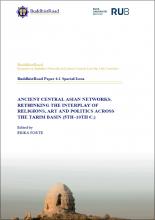BuddhistRoad Paper 6.1. Special Issue: Ancient Central Asian Networks, ed. Erika Forte. “Conveying India to the Pamir and Further Away: On Divine Hierarchy and Political Paradigms in Buddhist Texts”
Synopsis
While relatively early we see that some of the prominent Indian gods and diis minores are current interlocutors of the Buddha, at some point epic‘s characters are introduced in Buddhist narrative and become even 'divinized/deified' figures, some of them as mere name, other with a subtle reference to their original and specific physiognomy if not pedigree. On their part, the lords of land essentials in regulating social order were possibly the first agents with whom the Buddhists entered mundane transactions with the hosting society for the sake of installing the institution. And the success of the enterprise was depending upon the subtle 'coalescence' of their respective common law and/or juridical system. The hierarchy of the various divinities attested in epigraphy and in secular documents while in a way indicates the degree of reciprocal permeability of the Buddhist institution and the outer society, equally informs the historian about the possible itineraries taken by texts and their conveyors.
Chinese Translation
我们很早就知道一些著名的印度神祇和diis minores现在是佛陀的对话者, 某些时候, 史诗中的人物被引入佛教叙事, 甚至成为 “神化/被奉若神明”的人物, 其中一些只是名字, 另一些则隐晦地涉及他们原始和特定的面相—如果不是因为血统的话. 管理社会秩序的土地领主可能是佛教徒与佛教传入的社会进行世俗交易的第一个中间人, 其目的是为了建立佛教组织. 这项事业的成功取决于他们各自的普通法和/或司法系统微妙的 “联合”. 碑铭和世俗文献中体现的众神等级, 在某种程度上表明了佛教组织与世俗社会相互渗透的程度, 同时也让历史学家了解到文本及其传递者可能的互动路径.

Downloads
Published
Categories
License

This work is licensed under a Creative Commons Attribution-NonCommercial-ShareAlike 4.0 International License.

